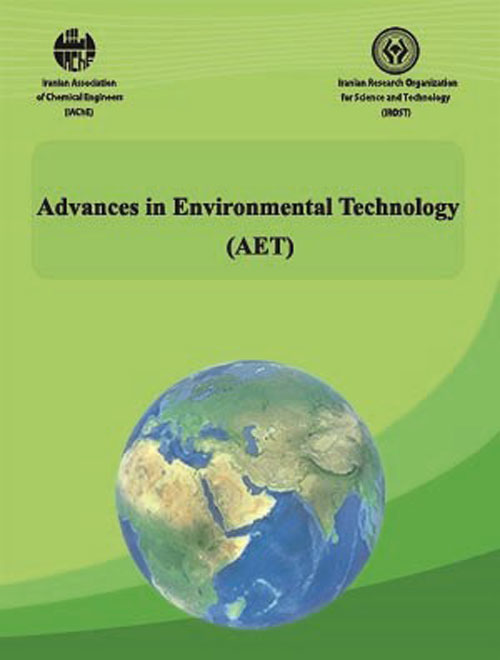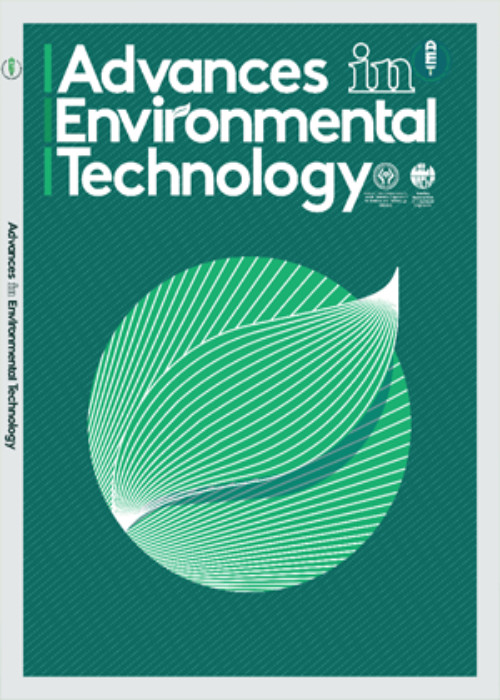فهرست مطالب

Advances in Environmental Technology
Volume:2 Issue: 1, Winter 2016
- تاریخ انتشار: 1395/05/11
- تعداد عناوین: 6
-
-
Pages 1-10Methanol as a biofuel is an environmentally friendly substitute for pure diesel and can be obtained from biomasses. The use of biofuels such as methanol for the combustion process is associated with positive impacts on the environment. Using pure methanol or a blend of diesel/methanol fuel in motorized vehicles has been proposed by researchers. In this paper, pure methanol was injected into the combustion chamber of a ISM 370 HD diesel engine and the exhaust emissions were evaluated by using AVL FIRE CFD code software at four engine speeds (1200, 1400, 1600 and 1800 rpm). Additionally, the influences of EGR mass fraction and various injection timings were investigated. In order to validate the simulation results, in-cylinder mean pressure and rate of heat release (RHR) were compared with experimental data, and the results gave an acceptable agreement. The obtained results from the conducted simulation showed that the use of methanol fuel in the combustion chamber dramatically reduced the amount of exhaust emissions such as NO, soot, CO, and CO2 to 90%, 75%, 40%, and 26%, respectively. In addition, a mass fraction of EGR (20%) caused a reduction in the amount of exhaust NO to about 12%. It was determined that when a system is equipped with a fueling system at 3 deg before top dead center (BTDC), the exhaust NO and soot are reduced by 5.8% and 3%.Keywords: HD diesel engine, Exhaust emissions, EGR, Injection timing, Methanol biofuel
-
Pages 11-24In the present investigation, a ZnO nanostructure was synthesized by means of precipitation and sonochemical methods. The X-ray diffraction (XRD) pattern indicated that the wurtzite structure of ZnO had a hexagonal symmetry and there was no impurity. The average ZnO particles crystallite size was calculated at about 41 nm. The SEM and TEM images revealed nanostructure ZnO particles with a cauliflower-like and rod morphology with dimensions of 85, 79 and 117 nm. In order to investigate the increment of ZnO photoactivity under visible light, the CuO doped ZnO nanostructures were fabricated by a wet impregnation method using copper oxide as the copper source and ZnO as the precursor. The XRD analysis confirmed that the CuO phase was present in the as-prepared sample and the average size of nano crystalline decreased to about 36 nm. The DRS spectra indicated the extended absorption of CuO-ZnO to the visible range as a result of band gap reduction to 2.9 eV (in comparison of 3.2 eV in ZnO). In order to investigate the photocatalytic activity of the synthesized photocatalyst, the degradation of 4-Chlorophenol under visible light was performed. Sixteen experiments using full factorial were executed by adjusting four parameters (amount of catalyst, initial concentration of 4-Chlorophenol, pH, and time of irradiation). An empirical expression was proposed and successfully used to model the photocatalytic process with a high correlation, and an optimal experimental region was also obtained. According to the developed model for degradation and the subsequent ANOVA test using Design Expert software, the time of irradiation with a 46.57% effect played the most important role in the photocatalytic activity, while the influences of parameters on each other were negligible. Optimal experimental conditions for 4-Chlorophenol concentration (0.01 g/L) were found at an initial pH =8 and a catalyst loading of 0.07 g/L. The results indicated that CuO-ZnO can remove 95% of 4-chlorophenol from water under optimal conditions.Keywords: CuO doped ZnO, Photocatalytic degradation, Visible light, 4, Chlorophenol
-
Pages 25-31Methoxy polyethylene glycol modified magnetite nanoparticles (PEGMNs) were synthesized and characterized by scanning electron microscopy (SEM), vibrating sample magnetometer (VSM), and X-ray diffraction (XRD). The adsorption of diazinon onto PEGMNs was investigated by UV-Vis spectrophotometry at 236 nm, through batch experiments. The effects of adsorbent dosage, solution pH, contact time, solution temperature and water impurities on the adsorption of diazinon onto PEGMNs were investigated. The process of adsorption was increased rapidly in the first contact period of 10 min. The adsorption at equilibrium (qe) was found to increase with increasing pH. The results of diazinon removal at various PEGMNs dosages demonstrated that the optimum dose of PEGMNs was 1mg. The amount of adsorption of diazinon at equilibrium increased with an increasing temperature from 15°C to 45°C that indicateds an endothermic process. Therefore, PEGMNs were used as an efficient absorbent for the removal of diazinon.Keywords: Adsorption, Spectrophotometry, Pesticides, Fe3O4
-
Pages 33-44In this work, response surface methodology (RSM) and artificial neural network (ANN) were used to predict the decolorization efficiency of Reactive Red 33 (RR 33) by applying the O3/UV process in a bubble column reactor. The effects of four independent variables including time (20-60 min), superficial gas velocity (0.06-0.18 cm/s), initial concentration of dye (50-150 ppm), and pH (3-11) were investigated using a 3-level 4-factor central composite experimental design. This design was utilized to train a feed-forward multilayered perceptron artificial neural network with a back-propagation algorithm. A comparison between the models results and experimental data gave high correlation coefficients and showed that the two models were able to predict Reactive Red 33 removal by employing the O3/UV process. Considering the results of the yield of dye removal and the response surface-generated model, the optimum conditions for dye removal were found to be a retention time of 59.87 min, a superficial gas velocity of 0.18 cm/s, an initial concentration of 96.33 ppm, and a pH of 7.99.Keywords: Artificial neural network, Bubble column, Ozone, Ultraviolet, Response surface method, Reactive red 33
-
Pages 45-54This work presents a simulation approach to the design and economic evaluation of fuel oil hydrotreating processes for the control of SO2 and NOx emission in an Iranian steam power plant. The percent of fuel oil desulphurization was estimated from the SO2 emissions standards for power plants. Based on two different scenarios according to (I) European and (II) Iranian standards, the design and simulation of hydrodesulphurization reactors, separation, heat recovery, and amine gas sweetening sections were performed and an economic assessment of the plant was investigated for each scenario. The results indicated the following: the cost price of each barrel of low sulfur fuel oil produced in such plants was estimated at 4.24 US$ for scenario (I) and 3.17 US$ for scenario (II); the levelized cost of desulfurization in power production was estimated at 0.618 c/kWh for (I) and 0.463 c/kWh for (II); and the social cost savings of replacing every barrel of low sulfur fuel oil instead of one barrel of high sulfur fuel oil were estimated at 26.7 US$ for (I) and 13.6 US$ (II).Keywords: Fuel oil hydrotreating, Steam power plant, Emissions control, Social cost savings, National, international SO2 emissions standards
-
Pages 55-61The global use of pesticides has resulted in the contamination of various ecosystems worldwide. The impact of these pesticides can be reduced through bioremediation. The factors that influence the biodegradation rate include the isolation of efficient bacteria for use in remediation and the determination of optimal biodegradation conditions. In this study, malathion degrading bacteria were isolated from agricultural soil samples taken from the Arvandkenar region in Iran. To optimize the biodegradation of malathion by an isolated strain, the effect of four parameters (temperature, salinity, NH4Cl and K2HPO4) was evaluated while considering protein concentrations at different times. The malathion remaining in the media was measured using the gas chromatography method. A gram-negative bacterium strain BNA1 with malathion biodegrading ability was isolated from the soil sample which showed a 99% similarity to Serratia marcescens. The optimum biodegradation condition occurred at a temperature = 30 ˚C, salinity = 0 %, NH4Cl = 0.25 g/L and K2HPO4 = 0.25 g/L. A biodegradation efficiency of 65% was obtained under the above-mentioned condition. The results of this study revealed the significant capability of BNA1 in the biodegradation of malathion. Therefore, the use of an isolated strain may be considered as an important tool in the bioremediation of pesticide-contaminated soil.Keywords: Malathion, Serratia marcescens, Optimization, Biodegradation, Pesticide


